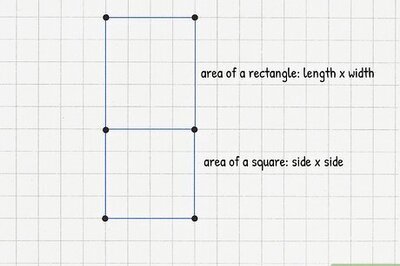
views
The photography craze that is taking the world by storm is actually 177 years old. It was in 1839 when amateur chemist and photography enthusiast Robert Cornelius (1809-1893) from Philadelphia took what is today believed to be the world's first ever selfie. Here is a collection of the world's oldest selfies.
 This 1839 self-photograph by amateur chemist and photography enthusiast Robert Cornelius (1809-1893) from Philadelphia is believed to be the world's first ever selfie.
This 1839 self-photograph by amateur chemist and photography enthusiast Robert Cornelius (1809-1893) from Philadelphia is believed to be the world's first ever selfie.
 Self portrait daguerreotype by Antoine Francois Jean Claudet (1797-1867). After learning about the daguerreotype process from Louis Daguerre (1787-1851) in Paris, Claudet moved to London and set up a daguerreotype portrait studio in 1841, directly competing with Richard Beard (c 1801-c 1888). After much rivalry, Claudet became the more successful of the two and was appointed the official photographer to Queen Victoria. He invented the red darkroom light, discovered a way to reduce exposure time for daguerreotypes, and was the first to use painted backgrounds and props in photographs.
Self portrait daguerreotype by Antoine Francois Jean Claudet (1797-1867). After learning about the daguerreotype process from Louis Daguerre (1787-1851) in Paris, Claudet moved to London and set up a daguerreotype portrait studio in 1841, directly competing with Richard Beard (c 1801-c 1888). After much rivalry, Claudet became the more successful of the two and was appointed the official photographer to Queen Victoria. He invented the red darkroom light, discovered a way to reduce exposure time for daguerreotypes, and was the first to use painted backgrounds and props in photographs.
 Daguerreotype self-portrait of Robert Cornelius pouring the contents of a beaker and a bottle through a funnel into a another beaker.
Daguerreotype self-portrait of Robert Cornelius pouring the contents of a beaker and a bottle through a funnel into a another beaker.
 Circa 1855 photograph thought to be a self-portrait by William Morris Grundy wearing North African robes and smoking a hookah.
Circa 1855 photograph thought to be a self-portrait by William Morris Grundy wearing North African robes and smoking a hookah.
 A self-portrait of the English photographer Francis Frith (1822-1898) in Turkish summer costume.
A self-portrait of the English photographer Francis Frith (1822-1898) in Turkish summer costume.
 Circa 1865 photograph by Oscar Gustav Rejlander (1813-1875) who produced composite images by piecing together several negatives. In this double self-portrait he appears both as an artist and as a military volunteer.
Circa 1865 photograph by Oscar Gustav Rejlander (1813-1875) who produced composite images by piecing together several negatives. In this double self-portrait he appears both as an artist and as a military volunteer.
 Circa 1872 self-portrait photograph by Oscar Gustav Rejlander (1813-1875) with his wife Mary.
Circa 1872 self-portrait photograph by Oscar Gustav Rejlander (1813-1875) with his wife Mary.
 Circa 1880. Carte de visite self-portrait photograph with his first wife, Helena (died 1895) and their daughter Ethel, taken during the time Friese-Greene ran a portrait studio in Gay Street, Bath. Film manufacturer, inventor and photographer, Friese-Greene (1855-1921) became interested in animated pictures in the 1880s after meeting John Rudge, who made magic lanterns and slides. He was involved in the development of motion pictures throughout his life through his constant inventions and innovations.
Circa 1880. Carte de visite self-portrait photograph with his first wife, Helena (died 1895) and their daughter Ethel, taken during the time Friese-Greene ran a portrait studio in Gay Street, Bath. Film manufacturer, inventor and photographer, Friese-Greene (1855-1921) became interested in animated pictures in the 1880s after meeting John Rudge, who made magic lanterns and slides. He was involved in the development of motion pictures throughout his life through his constant inventions and innovations.
 Circa 1860s. Photographic self-portrait by Charles Lutwidge Dodgson (1832-1898), better known by his pseudonym Lewis Carroll. Carroll was the author of the classic children's book 'Alice's Adventures in Wonderland' (1865). He was one of a very small number of mainly British amateur photographers who excelled during the early years of photography, producing far less stilted and artificial portraits, especially of children, than those taken by the vast numbers of professional portraitists of the time.
Circa 1860s. Photographic self-portrait by Charles Lutwidge Dodgson (1832-1898), better known by his pseudonym Lewis Carroll. Carroll was the author of the classic children's book 'Alice's Adventures in Wonderland' (1865). He was one of a very small number of mainly British amateur photographers who excelled during the early years of photography, producing far less stilted and artificial portraits, especially of children, than those taken by the vast numbers of professional portraitists of the time.
 Circa 1845. Self portrait of early photographer David Octavius Hill (1802-1870), left, and WB Johnstone. Hill was primarily a painter and first used photographs as a means of painting an accurate likeness. He worked with his friend, Scottish chemist Robert Adamson, and used the rough, grainy results produced by Fox-Talbot's calotype process to add depth to his subject. He preferred this method to the clarity of the image produced by a daguerreotype. When Adamson died in 1846 Hill returned to painting.
Circa 1845. Self portrait of early photographer David Octavius Hill (1802-1870), left, and WB Johnstone. Hill was primarily a painter and first used photographs as a means of painting an accurate likeness. He worked with his friend, Scottish chemist Robert Adamson, and used the rough, grainy results produced by Fox-Talbot's calotype process to add depth to his subject. He preferred this method to the clarity of the image produced by a daguerreotype. When Adamson died in 1846 Hill returned to painting.


















Comments
0 comment